More affordable and almost as good. If the Xiaomi 13 proves to be too expensive for your budget, consider exploring the more affordable Xiaomi 13T. It is similarly well-equipped and closely rivals the flagship in terms of performance. With a 6.67-inch display, the device features a remarkably bright AMOLED screen with a 144 Hz refresh rate, complemented by a triple camera system enhanced by Leica, featuring 2x optical zoom. Additionally, the Xiaomi 13T offers an impressive 5-year update support.
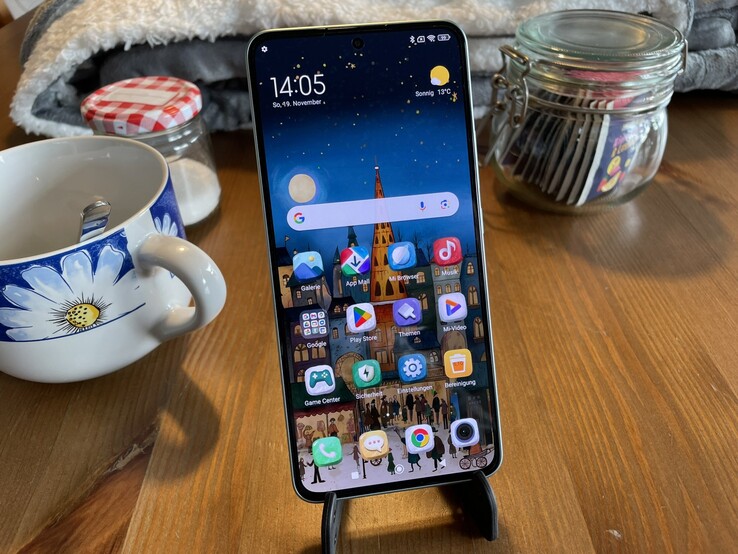
The Xiaomi 13T is the most affordable entry-level model in Xiaomi’s 13T series, positioned slightly below the Xiaomi 13 series. Priced at $599, it shares many similarities with its more expensive counterpart, offering an extensive range of features. Notable features include a 50 MP camera system developed in collaboration with Leica, incorporating a zoom lens, a remarkably bright AMOLED display with a 144 Hz refresh rate, and an impressive 5 years of extended software support.
The primary distinction between the Xiaomi 13T and the Xiaomi 13T Pro lies in the System on Chip (SoC). While the flagship Xiaomi 13T Pro employs the MediaTek Dimensity 9200+, the Xiaomi 13T utilizes the MediaTek Dimensity 8200-Ultra, positioning it slightly below the flagship level in terms of performance. Charging speed is also slightly more relaxed, with the Xiaomi 13T charging at a maximum of 67 watts, in contrast to the Xiaomi 13T Pro’s faster 120-watt charging capability.
Display
6.67 inch 20:9, 2712 x 1220 pixel 446 PPI, capacitive, AMOLED, Gorilla Glass 5, 2880Hz PWM-Dimming, 480Hz touch sampling rate, up to 1200 nits in high brightness mode, 2600 nits max brightness, HDR10, HDR10+, Dolby Vision, glossy: yes, HDR, 144 Hz
Storage
256 GB UFS 3.1 Flash, 256 GB
, 256GB, 221.6 GB free
Connections
1 USB 2.0, USB-C Power Delivery (PD), Audio Connections: USB-C, 1 Fingerprint Reader, NFC, Brightness Sensor, Sensors: Proximity sensor, 360° Ambient light sensor, Accelerometer, Gyroscope, Electronic compass, Linear motor, IR blaster, Flicker sensor, Color sensor, eSIM, 2×2 MIMO, Wi‑Fi Direct, DRM Widevine L1, Camera2 API Level 3
Networking
802.11 a/b/g/n/ac/ax (a/b/g/n = Wi-Fi 4/ac = Wi-Fi 5/ax = Wi-Fi 6/), Bluetooth 5.4, 2G (850/900/1800/1900 MHz), 3G (Band 1/2/4/5/6/8/19), 4G (Band 1/2/3/4/5/7/8/12/13/17/18/19/20/26/28/32/38/40/41/66), 5G (Band n1/3/5/7/8/20/28/38/40/41/66/77/78); Head SAR 0,991 W/kg, Body SAR 0.994 W/kg, Dual SIM, LTE, 5G, GPS
Size
height x width x depth (in mm): 8.49 x 162.2 x 75.7 ( = 0.33 x 6.39 x 2.98 in)
Battery
5000 mAh Lithium-Polymer
Charging
fast charging / Quickcharge
Operating System
Android 13
Camera
Primary Camera: 50 MPix (Sony IMX707, OIS, AF, f/1.9, 24mm, 1.22µm, 1/1.28″) + 50MP telefoto camera (Omnivision OV50D, AF, 2x optical zoom, 20x digital zoom, f/1.9, 50mm, 0.61µm, 1/2.88″) + 12MP ultrawide camera (FF, f/2.2, 15mm, 1.12µm, 1/3.06″), videos up to 4K@30fps
Secondary Camera: 20 MPix f/2.2, 0.8µm, 78° FOV, videos up to 1080p@30fps
Additional features
Speakers: stereo speaker with Dolby Atmos support, Keyboard: virtual, 67W charger, USB Type-C cable, SIM eject tool, Protective Case, Quick start guide, warranty card, safety information, MIUI 14, 24 Months Warranty, fanless, waterproof
Weight
197 g ( = 6.95 oz / 0.43 pounds), Power Supply: 100 g ( = 3.53 oz / 0.22 pounds)
Note: The manufacturer may use components from different suppliers including display panels, drives or memory sticks with similar specifications.
|
Rating |
Date |
Model |
Weight |
Drive |
Size |
Resolution |
Best Price |
|---|---|---|---|---|---|---|---|
| 87.7 % |
12/2023 |
Xiaomi 13T Dimensity 8200-Ultra, Mali-G610 MP6 |
197 g | 256 GB UFS 3.1 Flash | 6.67″ | 2712×1220 | |
| 88.9 % |
11/2023 |
Google Pixel 8 Tensor G3, Mali-G715 MP7 |
187 g | 128 GB UFS 3.1 Flash | 6.20″ | 2400×1080 | |
| 90.5 % |
03/2023 |
Samsung Galaxy S23 SD 8 Gen 2 for Galaxy, Adreno 740 |
167 g | 128 GB UFS 3.1 Flash | 6.10″ | 2340×1080 | |
| 83.1 % |
09/2023 |
Sony Xperia 10 V SD 695 5G, Adreno 619 |
159 g | 128 GB UFS 2.2 Flash | 6.10″ | 2520×1080 | |
| 88.1 % |
10/2023 |
Xiaomi 13T Pro Dimensity 9200+, Immortalis-G715 MP11 |
206 g | 512 GB UFS 4.0 Flash | 6.67″ | 2712×1220 | |
| 86.8 % |
09/2023 |
Xiaomi Poco F5 SD 7+ Gen 2, Adreno 725 |
181 g | 256 GB UFS 3.1 Flash | 6.67″ | 2400×1080 |
The Xiaomi 13T adheres to the design language of its predecessors, featuring narrow display edges, rounded corners and edges, a punch-hole selfie camera, and impeccable finishing. This design is consistent with its sister model, the Xiaomi 13T Pro. The front of the device is protected by a layer of Gorilla Glass 5, safeguarding the 6.67-inch AMOLED display. While the display-to-surface ratio stands at a respectable 87%, it falls slightly short of the Xiaomi 13T Pro (89.2%) and some other flagship smartphones.
As an IP68-certified device, the Xiaomi 13T is available in three color variants. The black (Black) and green (Meadow Green) options feature a glossy glass back, prone to fingerprints. Opting for the blue variant, known as Alpine Blue, results in a back cover made of artificial leather. This choice has a minimal impact on the dimensions and weight. With the glass back, the Xiaomi weighs only 0.43 lb.
{element.classList.add(‘hideEl’)});document.getElementById(‘showDeviceSizelabel_341352’).checked = false;document.querySelectorAll(‘#showDeviceSize_342308’).forEach(element => {element.classList.add(‘hideEl’)});document.getElementById(‘showDeviceSizelabel_342308’).checked = false;document.querySelectorAll(‘#showDeviceSize_338005’).forEach(element => {element.classList.add(‘hideEl’)});document.getElementById(‘showDeviceSizelabel_338005’).checked = false;document.querySelectorAll(‘#showDeviceSize_338988’).forEach(element => {element.classList.add(‘hideEl’)});document.getElementById(‘showDeviceSizelabel_338988’).checked = false;document.querySelectorAll(‘#showDeviceSize_341849’).forEach(element => {element.classList.add(‘hideEl’)});document.getElementById(‘showDeviceSizelabel_341849’).checked = false;document.querySelectorAll(‘#showDeviceSize_335208’).forEach(element => {element.classList.add(‘hideEl’)});document.getElementById(‘showDeviceSizelabel_335208’).checked = false;return false;” title=”hide all”>❌
The Xiaomi 13T is exclusively available in a single memory variant, featuring 8 GB LPDDR5 RAM and 256 GB UFS 3.1 storage. Its comprehensive set of features includes Bluetooth 5.4, NFC, an OTG-capable USB-C port, and an always-on display. Additionally, the device is equipped with an IR blaster for convenient remote control of compatible devices such as televisions.
It’s worth noting that the Xiaomi 13T’s USB-C port, while versatile, doesn’t fully align with the smartphone’s premium-class positioning, as it operates internally at USB 2.0 speed. In a copy test using the M.2 SSD Samsung 980 Pro in the Asus ROG Strix Arion Case, the USB port achieves a relatively low transfer rate of 41.4 MB/s. This is a characteristic shared with the Xiaomi 13T Pro, which also features USB-C 2.0.
The Xiaomi 13T operates on Android 13, complemented by Xiaomi’s proprietary MIUI 14 user interface. The software suite includes several third-party applications such as LinkedIn, Facebook, Snapchat, and TikTok, all of which can be uninstalled to tailor the device to individual preferences. Following the setup process, approximately 222 GB of the 256 GB storage on our test device remains available.
One notable aspect is Xiaomi’s commitment to a lengthy update period for the Xiaomi 13T. Similar to the Xiaomi 13T Pro, the test candidate is promised 4 Android OS updates and will receive Android security patches for 5 years. This extended software support places Xiaomi in line with Samsung, providing buyers with added planning security.
The smartphone delivers reliable Wi-Fi performance with its support for WiFi 6. When connected to our reference router, the Asus ROG Rapture GT-AXE11000, the smartphone achieves peak speeds of around 920 MBit/s in both transmit and receive directions. The transmissions exhibit stability, with minor drops observed only during data transmission. For users seeking even higher Wi-Fi speeds, considering the Xiaomi 13T Pro, which supports Wi-Fi 7, may be a preferable option.
In terms of mobile network connectivity, the Xiaomi 13T supports 5G, albeit without mmWave. Its frequency capabilities cover all essential bands for 4G in Europe. This suggests that the Xiaomi 13T should also offer good reception in non-EU countries.
| Networking | |
| Xiaomi 13T | |
| iperf3 receive AXE11000 |
|
| iperf3 transmit AXE11000 |
|
| Google Pixel 8 | |
| iperf3 receive AXE11000 |
|
| iperf3 transmit AXE11000 |
|
| iperf3 transmit AXE11000 6GHz |
|
| iperf3 receive AXE11000 6GHz |
|
| Samsung Galaxy S23 | |
| iperf3 receive AXE11000 |
|
| iperf3 transmit AXE11000 |
|
| iperf3 transmit AXE11000 6GHz |
|
| iperf3 receive AXE11000 6GHz |
|
| Sony Xperia 10 V | |
| iperf3 receive AXE11000 |
|
| iperf3 transmit AXE11000 |
|
| Xiaomi 13T Pro | |
| iperf3 receive AXE11000 |
|
| iperf3 transmit AXE11000 |
|
| iperf3 transmit AXE11000 6GHz |
|
| iperf3 receive AXE11000 6GHz |
|
| Xiaomi Poco F5 | |
| iperf3 receive AXE11000 |
|
| iperf3 transmit AXE11000 |
|
| iperf3 transmit AXE11000 6GHz |
|
| iperf3 receive AXE11000 6GHz |
|
| Average of class Smartphone | |
| iperf3 receive AXE11000 |
|
| iperf3 transmit AXE11000 |
|
| iperf3 transmit AXE11000 6GHz |
|
| iperf3 receive AXE11000 6GHz |
|
Xiaomi 13T Pro MediaTek Dimensity 9200+, ARM Immortalis-G715 MP11; iperf3 transmit AXE11000 6GHz; iperf 3.1.3: Ø1826 (934-1883)
Xiaomi 13T Pro MediaTek Dimensity 9200+, ARM Immortalis-G715 MP11; iperf3 receive AXE11000 6GHz; iperf 3.1.3: Ø1683 (1654-1717)
Xiaomi 13T MediaTek Dimensity 8200-Ultra, ARM Mali-G610 MP6; iperf3 receive AXE11000; iperf 3.1.3: Ø919 (904-931)
Xiaomi 13T Pro MediaTek Dimensity 9200+, ARM Immortalis-G715 MP11; iperf3 receive AXE11000; iperf 3.1.3: Ø966 (948-979)
Xiaomi 13T MediaTek Dimensity 8200-Ultra, ARM Mali-G610 MP6; iperf3 transmit AXE11000; iperf 3.1.3: Ø903 (493-1010)
Xiaomi 13T Pro MediaTek Dimensity 9200+, ARM Immortalis-G715 MP11; iperf3 transmit AXE11000; iperf 3.1.3: Ø972 (494-1008)
It utilizes dual-band GNSS for accurate positioning. It supports various satellite navigation services, including GPS (L1, L5), Galileo (E1, E5a), Glonass (L1), Beidou (B1, B1c, B2a), and QZSS (L1, L5). Whether indoors or outdoors, the smartphone rapidly acquires a positioning signal in tests, determining the user’s location with an impressive accuracy of up to 1 meter.
In a practical test during a bike ride, the Xiaomi 13T demonstrated its excellent location capabilities when compared to the Garmin Venu 2 fitness smartwatch. The results were convincing, showcasing the smartphone’s precise tracking of the distance traveled, making it well-suited for everyday navigation tasks.
The phone provides dual SIM functionality along with the option to substitute one of the two nano SIM cards with an eSIM. It supports VoLTE (Voice over LTE) and Wi-Fi calls, offering versatile connectivity options.
In terms of voice quality, the Xiaomi smartphone performs admirably. During calls to both mobile and landline networks, voices are transmitted with clarity and distinction, even in hands-free mode. Additionally, the device’s noise suppression feature works reliably, contributing to an overall positive calling experience.

Compared to its predecessor, the Xiaomi 12T, Xiaomi has elevated the camera setup on the 13T in collaboration with Leica. This upgrade not only involves a partnership with Leica but also results in a more cohesive overall system. Like the Xiaomi 12T, the Xiaomi 13T features a triple camera setup at the rear. The 2 MP macro camera from its predecessor, which wasn’t particularly practical, has been omitted. Instead, the Xiaomi 13T now shares an identical camera setup with the Xiaomi 13T Pro.
The primary camera on the Xiaomi 13T is the 50 MP Sony IMX707 (f/1.9, 24 mm), equipped with optical image stabilization, and bears the Leica Vario-Summicron 1:19-2.2/15-50 ASPH branding on the back of the smartphone. Additionally, there is a 12 MP ultra-wide-angle camera (Omnivision OV13b, f/2.2, 15 mm), and as a notable feature, a 50 MP telephoto camera with a 2x optical zoom and a 20x digital zoom (Omnivision OV50D, f/1.9, 50 mm). The camera array is completed by the 20 MP punch-hole selfie camera, capable of capturing good photos but limited to recording videos in Full HD resolution at 30 frames per second.
The collaboration with Leica introduces two image modes, Leica Vivid and Leica Authentic, along with numerous photo setting options. These modes, accessible via a separate icon in the camera app, each feature slightly different color calibrations. Additionally, various Leica filters are available to enhance photos. The main camera can record videos at up to 4K at 30 frames per second.
In daylight conditions, the main camera excels at capturing excellent photos with minimal image noise, consistently maintaining sharpness thanks to optical image stabilization. The Leica Vivid mode produces strong contrasts, while Leica Authentic tends to provide softer contrasts. The main camera also performs well in capturing night shots. However, compared to the Xiaomi 13T Pro, which shares the same photo hardware, the level of detail is somewhat lower, and the photos appear less dynamic. This difference could be attributed to the distinct SoC (Xiaomi 13T Pro: MediaTek Dimensity 9200+).
The telephoto camera, also boasting a 50 MP resolution, delivers high-contrast and sharp photos at lossless zoom levels of up to 2x, demonstrating an overall commendable performance. Images get hazy rapidly while using digital zoom. The weakest link in the Xiaomi 13T’s camera ensemble is the 12 MP ultra-wide-angle camera. While it performs adequately, it doesn’t offer more than standard photo quality, comparable to that of much more affordable smartphones.
Under controlled lighting conditions, the main camera demonstrates a commendable imaging performance. The Delta-E color deviations, reaching up to 21.23, are relatively significant. In particular, green tones are occasionally rendered much brighter than the reference colors of the ColorChecker color chart. Despite having only 1 lux of residual light, the Xiaomi 13T is still able to display the test chart, albeit with a noticeable level of blurring.
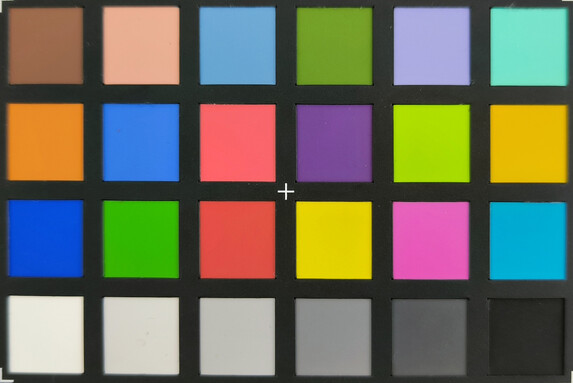
11.6 ∆E
8.3 ∆E
15.4 ∆E
21.2 ∆E
13.5 ∆E
8.9 ∆E
4.9 ∆E
15.3 ∆E
12 ∆E
9.7 ∆E
8.7 ∆E
9.2 ∆E
9.9 ∆E
13.3 ∆E
13.7 ∆E
4 ∆E
9.7 ∆E
13 ∆E
6.3 ∆E
6.1 ∆E
9.2 ∆E
8.6 ∆E
2.6 ∆E
4.8 ∆E
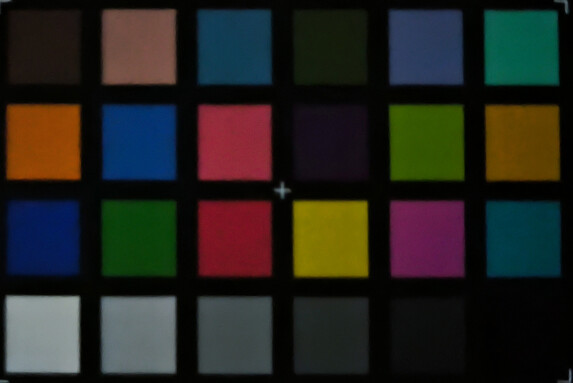
24 ∆E
29.1 ∆E
23.7 ∆E
26.6 ∆E
28.2 ∆E
36.4 ∆E
23.4 ∆E
15.3 ∆E
15.5 ∆E
22.9 ∆E
40 ∆E
40.6 ∆E
13.2 ∆E
28.1 ∆E
12.3 ∆E
27.1 ∆E
23.2 ∆E
26.1 ∆E
25.2 ∆E
27.9 ∆E
36 ∆E
30.6 ∆E
22.7 ∆E
13.3 ∆E
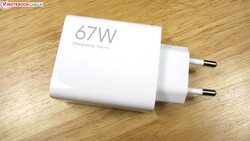
The Xiaomi 13T comes with a 67-watt power adapter (5-20V/6.2-3.25A), a USB-C cable, a transparent protective cover, a SIM tool, a quick start guide.
Unfortunately, there is no warranty coverage in the US.
With a refresh rate reaching up to 144 Hz and a dynamically adjusted sampling rate of up to 480 Hz depending on the content, the Xiaomi 13T delivers an exceptionally smooth content display. The device exhibits no noticeable delay between input and response, ensuring swift app switching, even with multiple applications open simultaneously.
Biometric authentication is facilitated through the optical fingerprint reader integrated into the display, offering quick and reliable performance. Additionally, 2D facial recognition is available for authentication, providing a rapid but less secure alternative.

The Xiaomi 13T features a 6.67-inch AMOLED display with a resolution of 2712 x 1220 pixels, resulting in a 20:9 aspect ratio and a high pixel density of 446 PPI. The panel supports HDR10, HDR10+, and Dolby Vision.
The display operates with a refresh rate of up to 144 Hz, dynamically adjusting in 5 steps. When set to 60 Hz in the Android settings, the screen runs at 30 or 60 Hz based on the displayed content. The alternative option is 144 Hz, utilizing all 5 levels at 30, 60, 90, 120, or 144 Hz.
Xiaomi claims a typical brightness of 1200 cd/m², with the ability to peak at 2600 cd/m². In a measurement with an even distribution of bright and dark image areas (APL18), the AMOLED display achieves an impressive 1452 cd/m², making it one of the brightest smartphone displays currently available. With HDR content, the screen reaches a maximum of 1278 cd/m², falling short of the targeted maximum value.
The display uses pulse width modulation (PWM) for screen brightness control, indicating that screen flickering is unavoidable. The amplitude curve is consistent at 120 Hz across the entire brightness spectrum. Xiaomi states that the 13T utilizes PWM dimming at a very high frequency of 2880 Hz, offering a more comfortable experience for sensitive users.
| 1197 cd/m² |
1269 cd/m² |
1276 cd/m² |
||
| 1270 cd/m² |
1254 cd/m² |
1274 cd/m² |
||
| 1253 cd/m² |
1181 cd/m² |
1273 cd/m² |
||
Distribution of brightness
tested with X-Rite i1Pro 3
Maximum: 1276 cd/m² (Nits) Average: 1249.7 cd/m² Minimum: 2.51 cd/m²
Brightness Distribution: 93 %
Center on Battery: 1254 cd/m²
Contrast: ∞:1 (Black: 0 cd/m²)
ΔE Color 0.8 | 0.5-29.43 Ø5.1
ΔE Greyscale 1.3 | 0.57-98 Ø5.3
98.6% sRGB (Calman 2D)
Gamma: 2.21
| Xiaomi 13T AMOLED, 2712×1220, 6.67 |
Google Pixel 8 OLED, 2400×1080, 6.20 |
Samsung Galaxy S23 Dynamic AMOLED 2x, 2340×1080, 6.10 |
Sony Xperia 10 V OLED, 2520×1080, 6.10 |
Xiaomi 13T Pro AMOLED, 2712×1220, 6.67 |
Xiaomi Poco F5 AMOLED, 2400×1080, 6.67 |
|
|---|---|---|---|---|---|---|
| Screen |
-39% |
-113% |
-21% |
-41% |
-69% |
|
| Brightness middle |
1254 |
1450 16% |
1125 -10% |
933 -26% |
1252 0% |
1034 -18% |
| Brightness |
1250 |
1410 13% |
1122 -10% |
944 -24% |
1230 -2% |
1033 -17% |
| Brightness Distribution |
93 |
92 -1% |
96 3% |
97 4% |
96 3% |
93 0% |
| Black Level * | ||||||
| Colorchecker dE 2000 * |
0.8 |
1.1 -38% |
3.2 -300% |
1.1 -38% |
1.4 -75% |
1.9 -138% |
| Colorchecker dE 2000 max. * |
1.6 |
4.2 -163% |
4.9 -206% |
1.7 -6% |
3.1 -94% |
3.7 -131% |
| Greyscale dE 2000 * |
1.3 |
2.1 -62% |
3.3 -154% |
1.8 -38% |
2.3 -77% |
2.7 -108% |
| Gamma |
2.21 100% |
2.24 98% |
1.97 112% |
2.29 96% |
2.23 99% |
2.24 98% |
| CCT |
6350 102% |
6584 99% |
6504 100% |
6611 98% |
6590 99% |
6917 94% |
* … smaller is better
Screen Flickering / PWM (Pulse-Width Modulation)
ℹ
To dim the screen, some notebooks will simply cycle the backlight on and off in rapid succession – a method called Pulse Width Modulation (PWM) . This cycling frequency should ideally be undetectable to the human eye. If said frequency is too low, users with sensitive eyes may experience strain or headaches or even notice the flickering altogether.
| Screen flickering / PWM detected | 120 Hz |
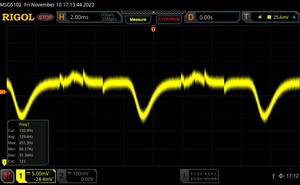 |
|
|
The display backlight flickers at 120 Hz (Likely utilizing PWM) . The frequency of 120 Hz is very low, so the flickering may cause eyestrain and headaches after extended use. In comparison: 53 % of all tested devices do not use PWM to dim the display. If PWM was detected, an average of 18683 (minimum: 5 – maximum: 3846000) Hz was measured. |
|||
Measurement series with fixed zoom level and different brightness settings
The AMOLED display of the Xiaomi 13T is finely calibrated at the factory. Transitioning from the default Vivid color scheme to the Original Color (the third option being Saturated), ensures that colors and grayscale are within the optimal range. For users who prefer the Vivid and Saturated color modes, there is the additional option to customize the color display by selecting the desired color temperature.
Display Response Times
ℹ
Display response times show how fast the screen is able to change from one color to the next. Slow response times can lead to afterimages and can cause moving objects to appear blurry (ghosting). Gamers of fast-paced 3D titles should pay special attention to fast response times.
| ↔ Response Time Black to White | ||
|---|---|---|
| 1.14 ms … rise ↗ and fall ↘ combined | ↗ 0.571 ms rise |
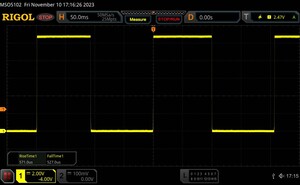 |
| ↘ 0.527 ms fall | ||
| The screen shows very fast response rates in our tests and should be very well suited for fast-paced gaming. In comparison, all tested devices range from 0.1 (minimum) to 240 (maximum) ms. » 2 % of all devices are better. This means that the measured response time is better than the average of all tested devices (21.8 ms). |
||
| ↔ Response Time 50% Grey to 80% Grey | ||
| 1.27 ms … rise ↗ and fall ↘ combined | ↗ 0.6 ms rise |
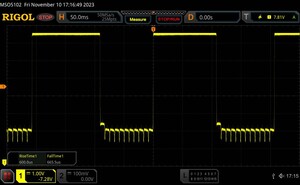 |
| ↘ 0.6655 ms fall | ||
| The screen shows very fast response rates in our tests and should be very well suited for fast-paced gaming. In comparison, all tested devices range from 0.2 (minimum) to 636 (maximum) ms. » 2 % of all devices are better. This means that the measured response time is better than the average of all tested devices (34.3 ms). |
||
The AMOLED display, known for its stable viewing angles, performs exceptionally well outdoors. Its high brightness reserves allow for easy readability of content even in direct sunlight. Additionally, a sunlight mode is available, adjusting the brightness in response to strong ambient light to further enhance visibility.

The MediaTek Dimensity 8200-Ultra, an advanced CPU specifically designed for Xiaomi with an enhanced camera ISP, is a variation of the otherwise identical MediaTek Dimensity 8200 and is the processor used in the Xiaomi 13T. An Imagiq 785 image processor handles the processing of camera data.
Manufactured using a 4 nm process, the MediaTek Dimensity 8200-Ultra features eight cores divided into two clusters. The first cluster comprises an ARM Cortex-A78 performance core clocked at 3.1 GHz, along with three additional ARM Cortex-A78 performance cores operating at 3 GHz. The second cluster houses four ARM Cortex-A55 power cores running at 2.0 GHz.
While the Xiaomi 13T may not match the SoC performance of its sister model, the Xiaomi 13T Pro, it still demonstrates commendable synthetic benchmark results. The Mediatek Dimensity 8200-Ultra performs similarly well to the Qualcomm Snapdragon 7+ Gen 2, found in devices like the Xiaomi Poco F5. The Google Tensor G3 in the Google Pixel 8 also achieves a comparable level of performance.
| Geekbench 5.5 | |
| Single-Core | |
| Samsung Galaxy S23 Qualcomm Snapdragon 8 Gen 2 for Galaxy, Adreno 740, 8192 |
|
| Xiaomi 13T Pro MediaTek Dimensity 9200+, Immortalis-G715 MP11, 12288 |
|
| Google Pixel 8 Google Tensor G3, Mali-G715 MP7, 8192 |
|
| Xiaomi Poco F5 Qualcomm Snapdragon 7+ Gen 2, Adreno 725, 8192 |
|
| Xiaomi 13T MediaTek Dimensity 8200-Ultra, Mali-G610 MP6, 8192 |
|
| Average MediaTek Dimensity 8200-Ultra |
|
| Average of class Smartphone (119 – 2138, n=220, last 2 years) |
|
| Sony Xperia 10 V Qualcomm Snapdragon 695 5G, Adreno 619, 6144 |
|
| Multi-Core | |
| Samsung Galaxy S23 Qualcomm Snapdragon 8 Gen 2 for Galaxy, Adreno 740, 8192 |
|
| Xiaomi 13T Pro MediaTek Dimensity 9200+, Immortalis-G715 MP11, 12288 |
|
| Xiaomi Poco F5 Qualcomm Snapdragon 7+ Gen 2, Adreno 725, 8192 |
|
| Xiaomi 13T MediaTek Dimensity 8200-Ultra, Mali-G610 MP6, 8192 |
|
| Average MediaTek Dimensity 8200-Ultra |
|
| Google Pixel 8 Google Tensor G3, Mali-G715 MP7, 8192 |
|
| Average of class Smartphone (473 – 5538, n=220, last 2 years) |
|
| Sony Xperia 10 V Qualcomm Snapdragon 695 5G, Adreno 619, 6144 |
|
| Geekbench 6.2 | |
| Single-Core | |
| Samsung Galaxy S23 Qualcomm Snapdragon 8 Gen 2 for Galaxy, Adreno 740, 8192 |
|
| Xiaomi Poco F5 Qualcomm Snapdragon 7+ Gen 2, Adreno 725, 8192 |
|
| Google Pixel 8 Google Tensor G3, Mali-G715 MP7, 8192 |
|
| Xiaomi 13T Pro MediaTek Dimensity 9200+, Immortalis-G715 MP11, 12288 |
|
| Average of class Smartphone (193 – 2930, n=60, last 2 years) |
|
| Xiaomi 13T MediaTek Dimensity 8200-Ultra, Mali-G610 MP6, 8192 |
|
| Average MediaTek Dimensity 8200-Ultra |
|
| Sony Xperia 10 V Qualcomm Snapdragon 695 5G, Adreno 619, 6144 |
|
| Multi-Core | |
| Samsung Galaxy S23 Qualcomm Snapdragon 8 Gen 2 for Galaxy, Adreno 740, 8192 |
|
| Xiaomi Poco F5 Qualcomm Snapdragon 7+ Gen 2, Adreno 725, 8192 |
|
| Google Pixel 8 Google Tensor G3, Mali-G715 MP7, 8192 |
|
| Xiaomi 13T MediaTek Dimensity 8200-Ultra, Mali-G610 MP6, 8192 |
|
| Average MediaTek Dimensity 8200-Ultra |
|
| Xiaomi 13T Pro MediaTek Dimensity 9200+, Immortalis-G715 MP11, 12288 |
|
| Average of class Smartphone (845 – 7244, n=60, last 2 years) |
|
| Sony Xperia 10 V Qualcomm Snapdragon 695 5G, Adreno 619, 6144 |
|
| Antutu v9 – Total Score | |
| Xiaomi 13T Pro MediaTek Dimensity 9200+, Immortalis-G715 MP11, 12288 |
|
| Samsung Galaxy S23 Qualcomm Snapdragon 8 Gen 2 for Galaxy, Adreno 740, 8192 |
|
| Xiaomi Poco F5 Qualcomm Snapdragon 7+ Gen 2, Adreno 725, 8192 |
|
| Xiaomi 13T MediaTek Dimensity 8200-Ultra, Mali-G610 MP6, 8192 |
|
| Average MediaTek Dimensity 8200-Ultra |
|
| Average of class Smartphone (102602 – 1478071, n=158, last 2 years) |
|
| Google Pixel 8 Google Tensor G3, Mali-G715 MP7, 8192 |
|
| Sony Xperia 10 V Qualcomm Snapdragon 695 5G, Adreno 619, 6144 |
|
| Antutu v10 – Total Score | |
| Samsung Galaxy S23 Qualcomm Snapdragon 8 Gen 2 for Galaxy, Adreno 740, 8192 |
|
| Average of class Smartphone (461567 – 1562239, n=16, last 2 years) |
|
| Google Pixel 8 Google Tensor G3, Mali-G715 MP7, 8192 |
|
| Xiaomi 13T MediaTek Dimensity 8200-Ultra, Mali-G610 MP6, 8192 |
|
| Average MediaTek Dimensity 8200-Ultra |
|
| PCMark for Android – Work 3.0 | |
| Samsung Galaxy S23 Qualcomm Snapdragon 8 Gen 2 for Galaxy, Adreno 740, 8192 |
|
| Xiaomi Poco F5 Qualcomm Snapdragon 7+ Gen 2, Adreno 725, 8192 |
|
| Xiaomi 13T MediaTek Dimensity 8200-Ultra, Mali-G610 MP6, 8192 |
|
| Average MediaTek Dimensity 8200-Ultra |
|
| Xiaomi 13T Pro MediaTek Dimensity 9200+, Immortalis-G715 MP11, 12288 |
|
| Average of class Smartphone (4761 – 19783, n=213, last 2 years) |
|
| Google Pixel 8 Google Tensor G3, Mali-G715 MP7, 8192 |
|
| Sony Xperia 10 V Qualcomm Snapdragon 695 5G, Adreno 619, 6144 |
|
| CrossMark – Overall | |
| Samsung Galaxy S23 Qualcomm Snapdragon 8 Gen 2 for Galaxy, Adreno 740, 8192 |
|
| Google Pixel 8 Google Tensor G3, Mali-G715 MP7, 8192 |
|
| Xiaomi 13T Pro MediaTek Dimensity 9200+, Immortalis-G715 MP11, 12288 |
|
| Xiaomi 13T MediaTek Dimensity 8200-Ultra, Mali-G610 MP6, 8192 |
|
| Average MediaTek Dimensity 8200-Ultra |
|
| Xiaomi Poco F5 Qualcomm Snapdragon 7+ Gen 2, Adreno 725, 8192 |
|
| Average of class Smartphone (200 – 1408, n=156, last 2 years) |
|
| Sony Xperia 10 V Qualcomm Snapdragon 695 5G, Adreno 619, 6144 |
|
| BaseMark OS II | |
| Overall | |
| Xiaomi 13T Pro MediaTek Dimensity 9200+, Immortalis-G715 MP11, 12288 |
|
| Samsung Galaxy S23 Qualcomm Snapdragon 8 Gen 2 for Galaxy, Adreno 740, 8192 |
|
| Xiaomi 13T MediaTek Dimensity 8200-Ultra, Mali-G610 MP6, 8192 |
|
| Average MediaTek Dimensity 8200-Ultra |
|
| Average of class Smartphone (411 – 9730, n=155, last 2 years) |
|
| Xiaomi Poco F5 Qualcomm Snapdragon 7+ Gen 2, Adreno 725, 8192 |
|
| Sony Xperia 10 V Qualcomm Snapdragon 695 5G, Adreno 619, 6144 |
|
| System | |
| Samsung Galaxy S23 Qualcomm Snapdragon 8 Gen 2 for Galaxy, Adreno 740, 8192 |
|
| Xiaomi 13T Pro MediaTek Dimensity 9200+, Immortalis-G715 MP11, 12288 |
|
| Xiaomi 13T MediaTek Dimensity 8200-Ultra, Mali-G610 MP6, 8192 |
|
| Average MediaTek Dimensity 8200-Ultra |
|
| Average of class Smartphone (2376 – 15148, n=155, last 2 years) |
|
| Sony Xperia 10 V Qualcomm Snapdragon 695 5G, Adreno 619, 6144 |
|
| Xiaomi Poco F5 Qualcomm Snapdragon 7+ Gen 2, Adreno 725, 8192 |
|
| Memory | |
| Xiaomi 13T Pro MediaTek Dimensity 9200+, Immortalis-G715 MP11, 12288 |
|
| Samsung Galaxy S23 Qualcomm Snapdragon 8 Gen 2 for Galaxy, Adreno 740, 8192 |
|
| Xiaomi 13T MediaTek Dimensity 8200-Ultra, Mali-G610 MP6, 8192 |
|
| Average MediaTek Dimensity 8200-Ultra |
|
| Average of class Smartphone (670 – 11617, n=155, last 2 years) |
|
| Xiaomi Poco F5 Qualcomm Snapdragon 7+ Gen 2, Adreno 725, 8192 |
|
| Sony Xperia 10 V Qualcomm Snapdragon 695 5G, Adreno 619, 6144 |
|
| Graphics | |
| Xiaomi 13T Pro MediaTek Dimensity 9200+, Immortalis-G715 MP11, 12288 |
|
| Samsung Galaxy S23 Qualcomm Snapdragon 8 Gen 2 for Galaxy, Adreno 740, 8192 |
|
| Xiaomi Poco F5 Qualcomm Snapdragon 7+ Gen 2, Adreno 725, 8192 |
|
| Average of class Smartphone (697 – 32002, n=155, last 2 years) |
|
| Xiaomi 13T MediaTek Dimensity 8200-Ultra, Mali-G610 MP6, 8192 |
|
| Average MediaTek Dimensity 8200-Ultra |
|
| Sony Xperia 10 V Qualcomm Snapdragon 695 5G, Adreno 619, 6144 |
|
| Web | |
| Xiaomi 13T Pro MediaTek Dimensity 9200+, Immortalis-G715 MP11, 12288 |
|
| Samsung Galaxy S23 Qualcomm Snapdragon 8 Gen 2 for Galaxy, Adreno 740, 8192 |
|
| Xiaomi 13T MediaTek Dimensity 8200-Ultra, Mali-G610 MP6, 8192 |
|
| Average MediaTek Dimensity 8200-Ultra |
|
| Average of class Smartphone (10 – 2044, n=155, last 2 years) |
|
| Xiaomi Poco F5 Qualcomm Snapdragon 7+ Gen 2, Adreno 725, 8192 |
|
| Sony Xperia 10 V Qualcomm Snapdragon 695 5G, Adreno 619, 6144 |
|
| UL Procyon AI Inference – Overall Score | |
| Xiaomi 13T Pro MediaTek Dimensity 9200+, Immortalis-G715 MP11, 12288 |
|
| Xiaomi 13T MediaTek Dimensity 8200-Ultra, Mali-G610 MP6, 8192 |
|
| Average MediaTek Dimensity 8200-Ultra |
|
| Google Pixel 8 Google Tensor G3, Mali-G715 MP7, 8192 |
|
| Average of class Smartphone (207 – 84787, n=128, last 2 years) |
|
| Samsung Galaxy S23 Qualcomm Snapdragon 8 Gen 2 for Galaxy, Adreno 740, 8192 |
|
| Xiaomi Poco F5 Qualcomm Snapdragon 7+ Gen 2, Adreno 725, 8192 |
|
| Sony Xperia 10 V Qualcomm Snapdragon 695 5G, Adreno 619, 6144 |
|
| AImark – Score v3.x | |
| Xiaomi 13T MediaTek Dimensity 8200-Ultra, Mali-G610 MP6, 8192 |
|
| Average MediaTek Dimensity 8200-Ultra |
|
| Average of class Smartphone (298 – 128240, n=79, last 2 years) |
|
| Samsung Galaxy S23 Qualcomm Snapdragon 8 Gen 2 for Galaxy, Adreno 740, 8192 |
|
| Xiaomi Poco F5 Qualcomm Snapdragon 7+ Gen 2, Adreno 725, 8192 |
|
| Google Pixel 8 Google Tensor G3, Mali-G715 MP7, 8192 |
|
| Sony Xperia 10 V Qualcomm Snapdragon 695 5G, Adreno 619, 6144 |
|
| Xiaomi 13T Pro MediaTek Dimensity 9200+, Immortalis-G715 MP11, 12288 |
|
For graphics calculations, the Xiaomi 13T uses the ARM GPU Mali-G610 MP6, providing the smartphone with a respectable graphics performance. Although, it doesn’t secure a top-ranking position among the compared devices. While the Xiaomi 13T outperforms the Sony Xperia 10 V, it falls just short of reaching the performance levels of the Xiaomi Poco F5 and the Google Pixel 8.
| 3DMark / Wild Life Extreme Unlimited | |
| Samsung Galaxy S23 Adreno 740, SD 8 Gen 2 for Galaxy, 128 GB UFS 3.1 Flash |
|
| Xiaomi 13T Pro Immortalis-G715 MP11, Dimensity 9200+, 512 GB UFS 4.0 Flash |
|
| Google Pixel 8 Mali-G715 MP7, Tensor G3, 128 GB UFS 3.1 Flash |
|
| Xiaomi Poco F5 Adreno 725, SD 7+ Gen 2, 256 GB UFS 3.1 Flash |
|
| Xiaomi 13T Mali-G610 MP6, Dimensity 8200-Ultra, 256 GB UFS 3.1 Flash |
|
| Sony Xperia 10 V Adreno 619, SD 695 5G, 128 GB UFS 2.2 Flash |
|
| 3DMark / Wild Life Extreme | |
| Samsung Galaxy S23 Adreno 740, SD 8 Gen 2 for Galaxy, 128 GB UFS 3.1 Flash |
|
| Xiaomi 13T Pro Immortalis-G715 MP11, Dimensity 9200+, 512 GB UFS 4.0 Flash |
|
| Google Pixel 8 Mali-G715 MP7, Tensor G3, 128 GB UFS 3.1 Flash |
|
| Xiaomi Poco F5 Adreno 725, SD 7+ Gen 2, 256 GB UFS 3.1 Flash |
|
| Xiaomi 13T Mali-G610 MP6, Dimensity 8200-Ultra, 256 GB UFS 3.1 Flash |
|
| Sony Xperia 10 V Adreno 619, SD 695 5G, 128 GB UFS 2.2 Flash |
|
| 3DMark / Wild Life Unlimited Score | |
| Samsung Galaxy S23 Adreno 740, SD 8 Gen 2 for Galaxy, 128 GB UFS 3.1 Flash |
|
| Xiaomi 13T Pro Immortalis-G715 MP11, Dimensity 9200+, 512 GB UFS 4.0 Flash |
|
| Google Pixel 8 Mali-G715 MP7, Tensor G3, 128 GB UFS 3.1 Flash |
|
| Xiaomi Poco F5 Adreno 725, SD 7+ Gen 2, 256 GB UFS 3.1 Flash |
|
| Xiaomi 13T Mali-G610 MP6, Dimensity 8200-Ultra, 256 GB UFS 3.1 Flash |
|
| Sony Xperia 10 V Adreno 619, SD 695 5G, 128 GB UFS 2.2 Flash |
|
| 3DMark / Wild Life Score | |
| Google Pixel 8 Mali-G715 MP7, Tensor G3, 128 GB UFS 3.1 Flash |
|
| Xiaomi Poco F5 Adreno 725, SD 7+ Gen 2, 256 GB UFS 3.1 Flash |
|
| Xiaomi 13T Mali-G610 MP6, Dimensity 8200-Ultra, 256 GB UFS 3.1 Flash |
|
| Sony Xperia 10 V Adreno 619, SD 695 5G, 128 GB UFS 2.2 Flash |
|
| 3DMark / Sling Shot Extreme (ES 3.1) Unlimited Physics | |
| Samsung Galaxy S23 Adreno 740, SD 8 Gen 2 for Galaxy, 128 GB UFS 3.1 Flash |
|
| Xiaomi 13T Mali-G610 MP6, Dimensity 8200-Ultra, 256 GB UFS 3.1 Flash |
|
| Google Pixel 8 Mali-G715 MP7, Tensor G3, 128 GB UFS 3.1 Flash |
|
| Xiaomi Poco F5 Adreno 725, SD 7+ Gen 2, 256 GB UFS 3.1 Flash |
|
| Xiaomi 13T Pro Immortalis-G715 MP11, Dimensity 9200+, 512 GB UFS 4.0 Flash |
|
| Sony Xperia 10 V Adreno 619, SD 695 5G, 128 GB UFS 2.2 Flash |
|
| 3DMark / Sling Shot Extreme (ES 3.1) Unlimited Graphics | |
| Samsung Galaxy S23 Adreno 740, SD 8 Gen 2 for Galaxy, 128 GB UFS 3.1 Flash |
|
| Xiaomi 13T Pro Immortalis-G715 MP11, Dimensity 9200+, 512 GB UFS 4.0 Flash |
|
| Xiaomi Poco F5 Adreno 725, SD 7+ Gen 2, 256 GB UFS 3.1 Flash |
|
| Google Pixel 8 Mali-G715 MP7, Tensor G3, 128 GB UFS 3.1 Flash |
|
| Xiaomi 13T Mali-G610 MP6, Dimensity 8200-Ultra, 256 GB UFS 3.1 Flash |
|
| Sony Xperia 10 V Adreno 619, SD 695 5G, 128 GB UFS 2.2 Flash |
|
| 3DMark / Sling Shot Extreme (ES 3.1) Unlimited | |
| Samsung Galaxy S23 Adreno 740, SD 8 Gen 2 for Galaxy, 128 GB UFS 3.1 Flash |
|
| Xiaomi 13T Pro Immortalis-G715 MP11, Dimensity 9200+, 512 GB UFS 4.0 Flash |
|
| Xiaomi Poco F5 Adreno 725, SD 7+ Gen 2, 256 GB UFS 3.1 Flash |
|
| Google Pixel 8 Mali-G715 MP7, Tensor G3, 128 GB UFS 3.1 Flash |
|
| Xiaomi 13T Mali-G610 MP6, Dimensity 8200-Ultra, 256 GB UFS 3.1 Flash |
|
| Sony Xperia 10 V Adreno 619, SD 695 5G, 128 GB UFS 2.2 Flash |
|
| GFXBench (DX / GLBenchmark) 2.7 / T-Rex Onscreen | |
| Samsung Galaxy S23 Adreno 740, SD 8 Gen 2 for Galaxy, 128 GB UFS 3.1 Flash |
|
| Xiaomi Poco F5 Adreno 725, SD 7+ Gen 2, 256 GB UFS 3.1 Flash |
|
| Xiaomi 13T Pro Immortalis-G715 MP11, Dimensity 9200+, 512 GB UFS 4.0 Flash |
|
| Google Pixel 8 Mali-G715 MP7, Tensor G3, 128 GB UFS 3.1 Flash |
|
| Xiaomi 13T Mali-G610 MP6, Dimensity 8200-Ultra, 256 GB UFS 3.1 Flash |
|
| Sony Xperia 10 V Adreno 619, SD 695 5G, 128 GB UFS 2.2 Flash |
|
| GFXBench (DX / GLBenchmark) 2.7 / T-Rex Offscreen | |
| Xiaomi 13T Pro Immortalis-G715 MP11, Dimensity 9200+, 512 GB UFS 4.0 Flash |
|
| Samsung Galaxy S23 Adreno 740, SD 8 Gen 2 for Galaxy, 128 GB UFS 3.1 Flash |
|
| Xiaomi Poco F5 Adreno 725, SD 7+ Gen 2, 256 GB UFS 3.1 Flash |
|
| Google Pixel 8 Mali-G715 MP7, Tensor G3, 128 GB UFS 3.1 Flash |
|
| Xiaomi 13T Mali-G610 MP6, Dimensity 8200-Ultra, 256 GB UFS 3.1 Flash |
|
| Sony Xperia 10 V Adreno 619, SD 695 5G, 128 GB UFS 2.2 Flash |
|
| GFXBench 3.0 / Manhattan Onscreen OGL | |
| Samsung Galaxy S23 Adreno 740, SD 8 Gen 2 for Galaxy, 128 GB UFS 3.1 Flash |
|
| Xiaomi 13T Pro Immortalis-G715 MP11, Dimensity 9200+, 512 GB UFS 4.0 Flash |
|
| Xiaomi Poco F5 Adreno 725, SD 7+ Gen 2, 256 GB UFS 3.1 Flash |
|
| Xiaomi 13T Mali-G610 MP6, Dimensity 8200-Ultra, 256 GB UFS 3.1 Flash |
|
| Google Pixel 8 Mali-G715 MP7, Tensor G3, 128 GB UFS 3.1 Flash |
|
| Sony Xperia 10 V Adreno 619, SD 695 5G, 128 GB UFS 2.2 Flash |
|
| GFXBench 3.0 / 1080p Manhattan Offscreen | |
| Xiaomi 13T Pro Immortalis-G715 MP11, Dimensity 9200+, 512 GB UFS 4.0 Flash |
|
| Samsung Galaxy S23 Adreno 740, SD 8 Gen 2 for Galaxy, 128 GB UFS 3.1 Flash |
|
| Xiaomi Poco F5 Adreno 725, SD 7+ Gen 2, 256 GB UFS 3.1 Flash |
|
| Xiaomi 13T Mali-G610 MP6, Dimensity 8200-Ultra, 256 GB UFS 3.1 Flash |
|
| Google Pixel 8 Mali-G715 MP7, Tensor G3, 128 GB UFS 3.1 Flash |
|
| Sony Xperia 10 V Adreno 619, SD 695 5G, 128 GB UFS 2.2 Flash |
|
| GFXBench 3.1 / Manhattan ES 3.1 Onscreen | |
| Samsung Galaxy S23 Adreno 740, SD 8 Gen 2 for Galaxy, 128 GB UFS 3.1 Flash |
|
| Xiaomi 13T Pro Immortalis-G715 MP11, Dimensity 9200+, 512 GB UFS 4.0 Flash |
|
| Xiaomi Poco F5 Adreno 725, SD 7+ Gen 2, 256 GB UFS 3.1 Flash |
|
| Xiaomi 13T Mali-G610 MP6, Dimensity 8200-Ultra, 256 GB UFS 3.1 Flash |
|
| Google Pixel 8 Mali-G715 MP7, Tensor G3, 128 GB UFS 3.1 Flash |
|
| Sony Xperia 10 V Adreno 619, SD 695 5G, 128 GB UFS 2.2 Flash |
|
| GFXBench 3.1 / Manhattan ES 3.1 Offscreen | |
| Xiaomi 13T Pro Immortalis-G715 MP11, Dimensity 9200+, 512 GB UFS 4.0 Flash |
|
| Samsung Galaxy S23 Adreno 740, SD 8 Gen 2 for Galaxy, 128 GB UFS 3.1 Flash |
|
| Xiaomi Poco F5 Adreno 725, SD 7+ Gen 2, 256 GB UFS 3.1 Flash |
|
| Xiaomi 13T Mali-G610 MP6, Dimensity 8200-Ultra, 256 GB UFS 3.1 Flash |
|
| Google Pixel 8 Mali-G715 MP7, Tensor G3, 128 GB UFS 3.1 Flash |
|
| Sony Xperia 10 V Adreno 619, SD 695 5G, 128 GB UFS 2.2 Flash |
|
| GFXBench / Car Chase Onscreen | |
| Samsung Galaxy S23 Adreno 740, SD 8 Gen 2 for Galaxy, 128 GB UFS 3.1 Flash |
|
| Xiaomi 13T Pro Immortalis-G715 MP11, Dimensity 9200+, 512 GB UFS 4.0 Flash |
|
| Xiaomi Poco F5 Adreno 725, SD 7+ Gen 2, 256 GB UFS 3.1 Flash |
|
| Google Pixel 8 Mali-G715 MP7, Tensor G3, 128 GB UFS 3.1 Flash |
|
| Xiaomi 13T Mali-G610 MP6, Dimensity 8200-Ultra, 256 GB UFS 3.1 Flash |
|
| Sony Xperia 10 V Adreno 619, SD 695 5G, 128 GB UFS 2.2 Flash |
|
| GFXBench / Car Chase Offscreen | |
| Samsung Galaxy S23 Adreno 740, SD 8 Gen 2 for Galaxy, 128 GB UFS 3.1 Flash |
|
| Xiaomi 13T Pro Immortalis-G715 MP11, Dimensity 9200+, 512 GB UFS 4.0 Flash |
|
| Xiaomi Poco F5 Adreno 725, SD 7+ Gen 2, 256 GB UFS 3.1 Flash |
|
| Google Pixel 8 Mali-G715 MP7, Tensor G3, 128 GB UFS 3.1 Flash |
|
| Xiaomi 13T Mali-G610 MP6, Dimensity 8200-Ultra, 256 GB UFS 3.1 Flash |
|
| Sony Xperia 10 V Adreno 619, SD 695 5G, 128 GB UFS 2.2 Flash |
|
| GFXBench / Aztec Ruins High Tier Onscreen | |
| Samsung Galaxy S23 Adreno 740, SD 8 Gen 2 for Galaxy, 128 GB UFS 3.1 Flash |
|
| Xiaomi 13T Pro Immortalis-G715 MP11, Dimensity 9200+, 512 GB UFS 4.0 Flash |
|
| Google Pixel 8 Mali-G715 MP7, Tensor G3, 128 GB UFS 3.1 Flash |
|
| Xiaomi Poco F5 Adreno 725, SD 7+ Gen 2, 256 GB UFS 3.1 Flash |
|
| Xiaomi 13T Mali-G610 MP6, Dimensity 8200-Ultra, 256 GB UFS 3.1 Flash |
|
| Sony Xperia 10 V Adreno 619, SD 695 5G, 128 GB UFS 2.2 Flash |
|
| GFXBench / Aztec Ruins High Tier Offscreen | |
| Samsung Galaxy S23 Adreno 740, SD 8 Gen 2 for Galaxy, 128 GB UFS 3.1 Flash |
|
| Xiaomi 13T Pro Immortalis-G715 MP11, Dimensity 9200+, 512 GB UFS 4.0 Flash |
|
| Google Pixel 8 Mali-G715 MP7, Tensor G3, 128 GB UFS 3.1 Flash |
|
| Xiaomi Poco F5 Adreno 725, SD 7+ Gen 2, 256 GB UFS 3.1 Flash |
|
| Xiaomi 13T Mali-G610 MP6, Dimensity 8200-Ultra, 256 GB UFS 3.1 Flash |
|
| Sony Xperia 10 V Adreno 619, SD 695 5G, 128 GB UFS 2.2 Flash |
|
| GFXBench / Aztec Ruins Normal Tier Onscreen | |
| Samsung Galaxy S23 Adreno 740, SD 8 Gen 2 for Galaxy, 128 GB UFS 3.1 Flash |
|
| Xiaomi Poco F5 Adreno 725, SD 7+ Gen 2, 256 GB UFS 3.1 Flash |
|
| Xiaomi 13T Pro Immortalis-G715 MP11, Dimensity 9200+, 512 GB UFS 4.0 Flash |
|
| Google Pixel 8 Mali-G715 MP7, Tensor G3, 128 GB UFS 3.1 Flash |
|
| Xiaomi 13T Mali-G610 MP6, Dimensity 8200-Ultra, 256 GB UFS 3.1 Flash |
|
| Sony Xperia 10 V Adreno 619, SD 695 5G, 128 GB UFS 2.2 Flash |
|
| GFXBench / Aztec Ruins Normal Tier Offscreen | |
| Samsung Galaxy S23 Adreno 740, SD 8 Gen 2 for Galaxy, 128 GB UFS 3.1 Flash |
|
| Xiaomi 13T Pro Immortalis-G715 MP11, Dimensity 9200+, 512 GB UFS 4.0 Flash |
|
| Google Pixel 8 Mali-G715 MP7, Tensor G3, 128 GB UFS 3.1 Flash |
|
| Xiaomi 13T Mali-G610 MP6, Dimensity 8200-Ultra, 256 GB UFS 3.1 Flash |
|
| Xiaomi Poco F5 Adreno 725, SD 7+ Gen 2, 256 GB UFS 3.1 Flash |
|
| Sony Xperia 10 V Adreno 619, SD 695 5G, 128 GB UFS 2.2 Flash |
|
| GFXBench / 4K Aztec Ruins High Tier Offscreen | |
| Samsung Galaxy S23 Adreno 740, SD 8 Gen 2 for Galaxy, 128 GB UFS 3.1 Flash |
|
| Xiaomi 13T Pro Immortalis-G715 MP11, Dimensity 9200+, 512 GB UFS 4.0 Flash |
|
| Xiaomi Poco F5 Adreno 725, SD 7+ Gen 2, 256 GB UFS 3.1 Flash |
|
| Google Pixel 8 Mali-G715 MP7, Tensor G3, 128 GB UFS 3.1 Flash |
|
| Xiaomi 13T Mali-G610 MP6, Dimensity 8200-Ultra, 256 GB UFS 3.1 Flash |
|
| Sony Xperia 10 V Adreno 619, SD 695 5G, 128 GB UFS 2.2 Flash |
|
Browser benchmarks reveal the Xiaomi 13T’s impressive performance, garnering it a good middle-of-the-road place among the selected comparison devices. The smartphone has quick web page loading times and responsive display performance.
| Jetstream 2 – Total Score | |
| Samsung Galaxy S23 (Chrome 109) |
|
| Xiaomi 13T Pro (Chrome 117) |
|
| Xiaomi Poco F5 (Chrome 116) |
|
| Google Pixel 8 (chrome 116) |
|
| Average of class Smartphone (21.2 – 351, n=165, last 2 years) |
|
| Average MediaTek Dimensity 8200-Ultra |
|
| Xiaomi 13T (Chrome 119.0.6045.163) |
|
| Sony Xperia 10 V (Chrome 116) |
|
| Speedometer 2.0 – Result | |
| Xiaomi 13T Pro (Chrome 117) |
|
| Samsung Galaxy S23 (Chrome 109) |
|
| Google Pixel 8 (chrome 116) |
|
| Xiaomi 13T (Chrome 119.0.6045.163) |
|
| Average MediaTek Dimensity 8200-Ultra |
|
| Xiaomi Poco F5 (Chrome 116) |
|
| Average of class Smartphone (14.9 – 445, n=153, last 2 years) |
|
| Sony Xperia 10 V (Chrome 116) |
|
| WebXPRT 4 – Overall Score | |
| Samsung Galaxy S23 (Chrome 109) |
|
| Xiaomi Poco F5 (Chrome 116) |
|
| Xiaomi 13T (Chrome 119.0.6045.163) |
|
| Average MediaTek Dimensity 8200-Ultra |
|
| Xiaomi 13T Pro (Chrome 117) |
|
| Google Pixel 8 (chrome 116) |
|
| Average of class Smartphone (25 – 202, n=125, last 2 years) |
|
| Sony Xperia 10 V (Chrome 116) |
|
| WebXPRT 3 – — | |
| Xiaomi 13T Pro (Chrome 117) |
|
| Xiaomi Poco F5 (Chrome 116) |
|
| Average of class Smartphone (37 – 304, n=130, last 2 years) |
|
| Xiaomi 13T (Chrome 119.0.6045.163) |
|
| Average MediaTek Dimensity 8200-Ultra |
|
| Google Pixel 8 (chrome 116) |
|
| Octane V2 – Total Score | |
| Samsung Galaxy S23 (Chrome 109) |
|
| Google Pixel 8 (chrome 116) |
|
| Xiaomi 13T (Chrome 119.0.6045.163) |
|
| Average MediaTek Dimensity 8200-Ultra |
|
| Xiaomi Poco F5 (Chrome 116) |
|
| Xiaomi 13T Pro (Chrome 117) |
|
| Average of class Smartphone (4633 – 89112, n=198, last 2 years) |
|
| Sony Xperia 10 V (Chrome 116) |
|
| Mozilla Kraken 1.1 – Total Score | |
| Average of class Smartphone (388 – 9999, n=163, last 2 years) |
|
| Sony Xperia 10 V (Chrome 116) |
|
| Average MediaTek Dimensity 8200-Ultra |
|
| Xiaomi 13T (Chrome 119.0.6045.163) |
|
| Xiaomi 13T Pro (Chrome 117) |
|
| Xiaomi Poco F5 (Chrome 116) |
|
| Google Pixel 8 (chrome 116) |
|
| Samsung Galaxy S23 (Chrome 109) |
|
* … smaller is better
Benefiting from its UFS 3.1 flash, the Xiaomi 13T achieves impressive storage speeds, resulting in short loading times. Notably, it closely approaches the performance of the Xiaomi 13T Pro when it comes to reading and writing small data blocks.
| Xiaomi 13T | Samsung Galaxy S23 | Sony Xperia 10 V | Xiaomi 13T Pro | Xiaomi Poco F5 | Average 256 GB UFS 3.1 Flash | Average of class Smartphone | |
|---|---|---|---|---|---|---|---|
| AndroBench 3-5 |
-24% |
-67% |
60% |
2% |
-25% |
-42% |
|
| Sequential Read 256KB |
1861.15 |
3133.7 {el.classList.toggle(‘hideEl’);});return false;”>?(UFS 4.0) 68% 1686.71 {el.classList.toggle(‘hideEl’);});return false;”>?(UFS 3.1) -9% |
444.54 -76% |
3983.36 114% |
1798.37 -3% |
1764 {el.classList.toggle(‘hideEl’);});return false;”>?(1004 – 2037, n=83) -5% |
1281 {el.classList.toggle(‘hideEl’);});return false;”>?(215 – 4512, n=217, last 2 years) -31% |
| Sequential Write 256KB |
1766.12 |
844 {el.classList.toggle(‘hideEl’);});return false;”>?(UFS 4.0) -52% 628.53 {el.classList.toggle(‘hideEl’);});return false;”>?(UFS 3.1) -64% |
438.02 -75% |
3201.74 81% |
1736.41 -2% |
1131 {el.classList.toggle(‘hideEl’);});return false;”>?(452 – 1873, n=83) -36% |
899 {el.classList.toggle(‘hideEl’);});return false;”>?(57.5 – 3202, n=217, last 2 years) -49% |
| Random Read 4KB |
380.76 |
427.61 {el.classList.toggle(‘hideEl’);});return false;”>?(UFS 4.0) 12% 343.65 {el.classList.toggle(‘hideEl’);});return false;”>?(UFS 3.1) -10% |
175.72 -54% |
434.21 14% |
389.37 2% |
282 {el.classList.toggle(‘hideEl’);});return false;”>?(173.5 – 543, n=83) -26% |
225 {el.classList.toggle(‘hideEl’);});return false;”>?(22.2 – 543, n=217, last 2 years) -41% |
| Random Write 4KB |
452.08 |
156.69 {el.classList.toggle(‘hideEl’);});return false;”>?(UFS 4.0) -65% 130.26 {el.classList.toggle(‘hideEl’);});return false;”>?(UFS 3.1) -71% |
165.15 -63% |
583.6 29% |
498.93 10% |
311 {el.classList.toggle(‘hideEl’);});return false;”>?(197.5 – 499, n=84) -31% |
238 {el.classList.toggle(‘hideEl’);});return false;”>?(13 – 584, n=218, last 2 years) -47% |
With the ARM Mali-G610 MP6 and 8 GB LPDDR5 RAM, the Xiaomi 13T handles games with minimal restrictions. The main limitations observed were within the games themselves during testing.
In games like PUBG Mobile (in the HD/Extrem) and Asphalt 9 (in the high setting), the image output is capped at a maximum of 60 FPS, likely for energy-saving purposes. However, the Xiaomi 13T consistently maintains the frame rate at a practically constant 60 FPS in both cases, indicating that higher performance is achievable.
Even in the UltraHDR/Ultra-setting of PUBG Mobile, the Xiaomi 13T maintains an average of 40 FPS. Notably, in our third test game, Subway Surfers, where there is no frame limit, the smartphone fully leverages its 120 Hz screen.
The determination of game frame rates is conducted using our Gamebench test tool.
Xiaomi 13T; Asphalt 9: Legends; 4.3.3a: Ø59.4 (51-61)
Xiaomi 13T; PUBG Mobile; HD; 2.9.0: Ø59.3 (57-61)
Xiaomi 13T; PUBG Mobile; Ultra HD; 2.9.0: Ø39.9 (38-41)
Xiaomi 13T; Subway Surfers; 3.20.0: Ø118.4 (111-121)
During testing, the Xiaomi 13T reached a temperature of 107.42 °F under load. This temperature is entirely benign and doesn’t result in the smartphone feeling uncomfortably warm when held.
Efficient heat dissipation is demonstrated by the Xiaomi 13T, as evidenced by the 3DMark’s Wild Life stress test. After 20 runs, the test scene is only rendered around 10 percent slower than at the beginning of the measurement, even in the demanding Wild Life Extreme scenario. This suggests that the smartphone can maintain at least 90% of its performance under constant high load.
|
|||||||||||||||||||||||||
| Maximum: 41.9 °C = 107 F Average: 41.5 °C = 107 F |
|||||||||||||||||||||||||
|
|||||||||||||||||||||||||
| Maximum: 40.7 °C = 105 F Average: 38.2 °C = 101 F |
|||||||||||||||||||||||||
Power Supply (max.) 27.4 °C = 81 F | Room Temperature 21.1 °C = 70 F | Fluke t3000FC (calibrated) & Voltcraft IR-260
(-) The average temperature for the upper side under maximal load is 41.5 °C / 107 F, compared to the average of 32.7 °C / 91 F for the devices in the class Smartphone.
(±) The maximum temperature on the upper side is 41.9 °C / 107 F, compared to the average of 35 °C / 95 F, ranging from 21.9 to 56 °C for the class Smartphone.
(±) The bottom heats up to a maximum of 40.7 °C / 105 F, compared to the average of 33.8 °C / 93 F
(+) In idle usage, the average temperature for the upper side is 22.6 °C / 73 F, compared to the device average of 32.7 °C / 91 F.
| 3DMark | |
| Wild Life Stress Test Stability | |
| Sony Xperia 10 V Adreno 619, SD 695 5G, 128 GB UFS 2.2 Flash |
|
| Xiaomi 13T Mali-G610 MP6, Dimensity 8200-Ultra, 256 GB UFS 3.1 Flash |
|
| Xiaomi Poco F5 Adreno 725, SD 7+ Gen 2, 256 GB UFS 3.1 Flash |
|
| Google Pixel 8 Mali-G715 MP7, Tensor G3, 128 GB UFS 3.1 Flash |
|
| Xiaomi 13T Pro Immortalis-G715 MP11, Dimensity 9200+, 512 GB UFS 4.0 Flash |
|
| Samsung Galaxy S23 Adreno 740, SD 8 Gen 2 for Galaxy, 128 GB UFS 3.1 Flash |
|
| Wild Life Extreme Stress Test | |
| Xiaomi Poco F5 Adreno 725, SD 7+ Gen 2, 256 GB UFS 3.1 Flash |
|
| Sony Xperia 10 V Adreno 619, SD 695 5G, 128 GB UFS 2.2 Flash |
|
| Xiaomi 13T Mali-G610 MP6, Dimensity 8200-Ultra, 256 GB UFS 3.1 Flash |
|
| Google Pixel 8 Mali-G715 MP7, Tensor G3, 128 GB UFS 3.1 Flash |
|
| Xiaomi 13T Pro Immortalis-G715 MP11, Dimensity 9200+, 512 GB UFS 4.0 Flash |
|
| Samsung Galaxy S23 Adreno 740, SD 8 Gen 2 for Galaxy, 128 GB UFS 3.1 Flash |
|
| Solar Bay Stress Test Stability | |
| Xiaomi 13T Pro Immortalis-G715 MP11, Dimensity 9200+, 512 GB UFS 4.0 Flash |
|
Xiaomi 13T Mali-G610 MP6, Dimensity 8200-Ultra, 256 GB UFS 3.1 Flash; Wild Life Extreme Stress Test; 1.1.4.1: Ø9.63 (9.32-10.3)
Google Pixel 8 Mali-G715 MP7, Tensor G3, 128 GB UFS 3.1 Flash; Wild Life Extreme Stress Test; 1.1.4.1: Ø12.7 (11.3-14.4)
Samsung Galaxy S23 Adreno 740, SD 8 Gen 2 for Galaxy, 128 GB UFS 3.1 Flash; Wild Life Extreme Stress Test; 1.1.0.2: Ø15.5 (12.4-23.1)
Sony Xperia 10 V Adreno 619, SD 695 5G, 128 GB UFS 2.2 Flash; Wild Life Extreme Stress Test; 1.1.4.1: Ø2.15 (2.14-2.16)
Xiaomi 13T Pro Immortalis-G715 MP11, Dimensity 9200+, 512 GB UFS 4.0 Flash; Wild Life Extreme Stress Test; 1.1.4.1: Ø17.8 (16.9-22)
Xiaomi Poco F5 Adreno 725, SD 7+ Gen 2, 256 GB UFS 3.1 Flash; Wild Life Extreme Stress Test; 1.1.4.1: Ø11.7 (11.7-11.8)
Xiaomi 13T Mali-G610 MP6, Dimensity 8200-Ultra, 256 GB UFS 3.1 Flash; Wild Life Stress Test Stability; 0.0.0.0: Ø35.9 (35.4-38.7)
Google Pixel 8 Mali-G715 MP7, Tensor G3, 128 GB UFS 3.1 Flash; Wild Life Stress Test Stability; 0.0.0.0: Ø46.6 (43.2-51.8)
Samsung Galaxy S23 Adreno 740, SD 8 Gen 2 for Galaxy, 128 GB UFS 3.1 Flash; Wild Life Stress Test Stability: Ø58.5 (52.3-76.3)
Sony Xperia 10 V Adreno 619, SD 695 5G, 128 GB UFS 2.2 Flash; Wild Life Stress Test Stability; 1.1.4.1: Ø7.21 (7.2-7.22)
Xiaomi 13T Pro Immortalis-G715 MP11, Dimensity 9200+, 512 GB UFS 4.0 Flash; Wild Life Stress Test Stability; 0.0.0.0: Ø57 (48.3-65.1)
Xiaomi Poco F5 Adreno 725, SD 7+ Gen 2, 256 GB UFS 3.1 Flash; Wild Life Stress Test Stability; 0.0.0.0: Ø40.9 (39.1-45.6)
Google Pixel 8 Mali-G715 MP7, Tensor G3, 128 GB UFS 3.1 Flash; Wild Life Unlimited Stress Test Stability; 0.0.0.0: Ø48.9 (43.5-53.7)
Google Pixel 8 Mali-G715 MP7, Tensor G3, 128 GB UFS 3.1 Flash; Wild Life Unlimited Stress Test Stability; 0.0.0.0: Ø48.9 (43.5-53.7)
Samsung Galaxy S23 Adreno 740, SD 8 Gen 2 for Galaxy, 128 GB UFS 3.1 Flash; Wild Life Unlimited Stress Test Stability: Ø66.7 (56-85.8)
Xiaomi Poco F5 Adreno 725, SD 7+ Gen 2, 256 GB UFS 3.1 Flash; Wild Life Unlimited Stress Test Stability; 0.0.0.0: Ø44.7 (39.7-46.1)
Xiaomi 13T Pro Immortalis-G715 MP11, Dimensity 9200+, 512 GB UFS 4.0 Flash; Solar Bay Stress Test Stability; 1.0.6.5: Ø17.1 (16.8-19.4)
The stereo speakers of the Xiaomi 13T are located on the two short sides of the casing and deliver a relatively balanced sound by smartphone standards. Bass is practically absent from the sound mix, but apart from that, the smartphone produces decent sound with mostly balanced highs and mids.
External audio devices can be connected via USB-C or Bluetooth 5.4. The Xiaomi 13T supports all important Bluetooth codecs, including AAC, SBC, LDAC, aptX, aptX HD, aptX Adaptive, aptX TWS+, and LHDC V1 to V5.
| Xiaomi 13T 5000 mAh |
Google Pixel 8 4575 mAh |
Samsung Galaxy S23 3900 mAh |
Sony Xperia 10 V 5000 mAh |
Xiaomi 13T Pro 5000 mAh |
Xiaomi Poco F5 5000 mAh |
Average MediaTek Dimensity 8200-Ultra |
Average of class Smartphone |
|
|---|---|---|---|---|---|---|---|---|
| Power Consumption |
27% |
49% |
43% |
1% |
9% |
0% |
17% |
|
| Idle Minimum * |
1.13 |
0.56 50% |
0.57 50% |
0.56 50% |
0.99 12% |
0.89 21% |
1.13 -0% |
0.89 {el.classList.toggle(‘hideEl’);});return false;”>?(0.44 – 2.37, n=155, last 2 years) 21% |
| Idle Average * |
1.37 |
1.08 21% |
0.74 46% |
0.91 34% |
1.14 17% |
1.05 23% |
1.37 -0% |
1.464 {el.classList.toggle(‘hideEl’);});return false;”>?(0.69 – 4.26, n=155, last 2 years) -7% |
| Idle Maximum * |
1.42 |
1.17 18% |
0.83 42% |
0.98 31% |
1.34 6% |
1.08 24% |
1.42 -0% |
1.669 {el.classList.toggle(‘hideEl’);});return false;”>?(0.79 – 4.45, n=155, last 2 years) -18% |
| Load Average * |
8.98 |
8.01 11% |
4.26 53% |
5.34 41% |
10.06 -12% |
10.86 -21% |
8.98 -0% |
4.84 {el.classList.toggle(‘hideEl’);});return false;”>?(2.4 – 15.3, n=155, last 2 years) 46% |
| Load Maximum * |
13.23 |
8.89 33% |
6.16 53% |
5.46 59% |
15.94 -20% |
13.49 -2% |
13.2 -0% |
7.71 {el.classList.toggle(‘hideEl’);});return false;”>?(3.85 – 17.8, n=155, last 2 years) 42% |
* … smaller is better
Xiaomi 13T MediaTek Dimensity 8200-Ultra; Geekbench 5.5 Power Consumption 150cd: Ø4.46 (1.205-10.9)
Samsung Galaxy S23 Qualcomm Snapdragon 8 Gen 2 for Galaxy; Geekbench 5.5 Power Consumption 150cd: Ø6.19 (0.819-14)
Xiaomi Poco F5 Qualcomm Snapdragon 7+ Gen 2; Geekbench 5.5 Power Consumption 150cd: Ø4.57 (0.819-10.1)
Xiaomi 13T MediaTek Dimensity 8200-Ultra; Idle 150cd/m2: Ø0.997 (0.937-1.285)
Samsung Galaxy S23 Qualcomm Snapdragon 8 Gen 2 for Galaxy; Idle 150cd/m2: Ø0.699 (0.602-1.197)
Xiaomi Poco F5 Qualcomm Snapdragon 7+ Gen 2; Idle 150cd/m2: Ø0.824 (0.707-0.916)
Xiaomi 13T MediaTek Dimensity 8200-Ultra; 1920×1080 Aztec Ruins Normal Offscreen: Ø5.65 (4.67-7.07)
Samsung Galaxy S23 Qualcomm Snapdragon 8 Gen 2 for Galaxy; 1920×1080 Aztec Ruins Normal Offscreen: Ø11.8 (10.5-13)
Xiaomi Poco F5 Qualcomm Snapdragon 7+ Gen 2; 1920×1080 Aztec Ruins Normal Offscreen: Ø6.27 (5.86-6.72)
Xiaomi 13T MediaTek Dimensity 8200-Ultra; Idle 150cd/m2: Ø0.997 (0.937-1.285)
Samsung Galaxy S23 Qualcomm Snapdragon 8 Gen 2 for Galaxy; Idle 150cd/m2: Ø0.699 (0.602-1.197)
Xiaomi Poco F5 Qualcomm Snapdragon 7+ Gen 2; Idle 150cd/m2: Ø0.824 (0.707-0.916)
We conducted practical measurements of battery life with the screen brightness adjusted to 150 cd/m². The Xiaomi 13T performs well with the 144 Hz display enabled. In the WLAN test, it lasts just over 17 hours, and just under 15 minutes more during continuous video playback. The comparison devices are on a similar level, with the exception of the Sony Xperia 10 V, which demonstrates true endurance qualities.
Battery Runtime
| Idle (without WLAN, min brightness) | 41h 51min | |
| WiFi Websurfing | 17h 06min | |
| Big Buck Bunny H.264 1080p | 17h 20min | |
| Load (maximum brightness) | 4h 07min |
Pros
+ high-quality and waterproof housing
+ ultra-bright AMOLED display with 144 Hz
+ good camera system
+ high performance
+ extended update period
+ fast charging with 67 watts
Cons
– USB-C 2.0 only
– no wireless charging
– only one memory variant, not expandable
Anyone who has waited until now to purchase a new smartphone might find the perfect fit in Xiaomi’s lineup. The T series, released towards the year’s end, consistently delivers models with impressive performance and features at a comparatively reasonable price. The Xiaomi 13T, while not a budget option at an official price of $599, is significantly more affordable than the current Xiaomi flagship models.
The Xiaomi 13T stands out as an excellent upper-class smartphone with extensive features, now available for less than $600.
Powered by the MediaTek Dimensity 8200-Ultra, it offers performance just below flagship level, distinguishing it from the Xiaomi 13T Pro, and boasts faster charging at 120 watts. The Xiaomi 13T, with its 67-watt charging, reaches a full charge in just 41 minutes, although it lacks wireless charging functionality.
Impressive across various system components, the Xiaomi 13T particularly excels with its very bright AMOLED display. Noteworthy in its price range is the camera module, including a 2x telephoto lens. The extended 5-year update period might sway those who have been hesitant about choosing Xiaomi.
However, users with high storage needs may be disappointed, as the Xiaomi 13T offers only a 256 GB version without the option to expand storage using a microSD card. In this regard, the Xiaomi 13T Pro, available with up to 1 TB capacity, provides a better solution.
Alternative options to consider include the Samsung Galaxy S23 and the Xiaomi Poco F5. The former offers slightly superior speed and a more compact size at 6.1 inches. While the Xiaomi Poco F5 is more budget-friendly, it falls short in the camera department compared to the Xiaomi 13T.
The Xiaomi 13T is available on Amazon for under $500.
Xiaomi 13T
–
12/07/2023 v7
Manuel Masiero
Application Performance
86 / 90 → 96%
Smartphone – Weighted Average
Transparency
The present review sample was made available to the author as a loan by the manufacturer or a shop for the purposes of review. The lender had no influence on this review, nor did the manufacturer receive a copy of this review before publication. There was no obligation to publish this review.
Pricecompare

My fascination for computers started with the C64. Since then, I’ve put everything that comes my way in terms of hardware through its paces. From the C64 to the Amiga 500 and the first PC with an 8088 CPU, my list of projects has grown increasingly longer. For more than 20 years now I have also turned my hobby into my profession and have been active in the mobile section of Notebookcheck since 2021. Before that, I worked as a hardware editor for IDG Media (tecChannel.de) and VNU Business Publications (PC professional), among others.

Translator: Carmen Pol – Translator – 57 articles published on Notebookcheck since 2023
Having spent the greater part of my early years in Germany facilitated my upbringing as a bilingual kid.
In 2007, I found myself having to reinstall my Windows weekly … So, one day I bought a MacBook Black.
It was during this period that I developed a profound appreciation for technology, which significantly improved my life.
Manuel Masiero, 2023-12- 8 (Update: 2023-12- 9)
